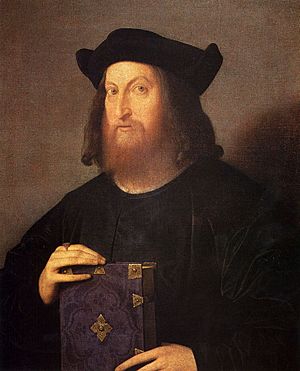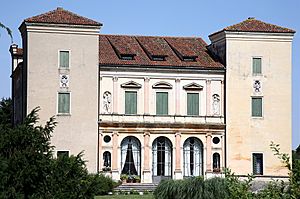Gian Giorgio Trissino facts for kids

Gian Giorgio Trissino (born July 8, 1478 – died December 8, 1550) was a very smart and talented person from Venice, Italy. He lived during the Renaissance, a time when art, learning, and new ideas were very important. Trissino was many things: a poet, a writer of plays, a diplomat (someone who represents their country), a language expert, and a philosopher. He even helped shape the Italian language!
Contents
Life of Gian Giorgio Trissino
Gian Giorgio Trissino was born into a wealthy family in Vicenza, Italy. In 1509, he supported Emperor Maximilian I when his army entered Vicenza. Because of this, when Venice took back control of Vicenza, Trissino was sent away from his home.
He traveled to Germany and other parts of Italy. In 1516, Venice forgave him, and he was allowed to return. Later, powerful leaders like Pope Leo X, Pope Clement VII, and Pope Paul III became his protectors.
Education and Early Career
Trissino received an excellent education. He studied Greek in Milan and philosophy in Ferrara. His deep knowledge impressed Pope Leo X, who sent him to Germany as an ambassador in 1515. Later, Pope Clement VII also favored him and used him as an ambassador.
In 1532, Emperor Charles V made Trissino a count. Even though he had been banished from Vicenza, he was highly respected across Italy. Wherever he lived, his home became a meeting place for scholars, writers, and other cultured people of his time.
Later Studies
From 1538 to 1540, Trissino went back to studying at the University of Padua. He was very interested in the ideas of Plato and the topic of free will.
Trissino died in Rome in December 1550. His collected works were published in Verona in 1729.
Literary Contributions
Trissino is an important figure in European literature. He wrote a famous tragedy play called Sophonisba.
The Tragedy Sophonisba
His play Sophonisba was written around 1515 and published in 1524. It was based on the life of a Carthaginian lady named Sophonisba. This play was one of the first modern tragedies to follow the old Greek and Roman rules for plays. It became an example for other European tragedies throughout the 1500s. The play was even translated into French and performed successfully in 1556.
The Epic Poem l'Italia liberata dai Goti
Trissino also wrote a long epic poem called l'Italia liberata dai Goti (Italy Liberated from the Goths), published in 1547–1548. He wanted to show that it was possible to write a long poem in Italian that followed classical rules, unlike the popular adventure stories of his time. This poem was about the wars of Belisarius in Italy. However, many people found it a bit dull.
Linguistics and Language Reform
Trissino was very interested in the Italian language. He wanted to improve it and make it richer.
Ideas on the Italian Language
Following the ideas of Dante, Trissino believed that the Italian language should be a mix of contributions from different refined centers in Italy. He argued against the idea that Italian was mainly from Tuscany. In his work Castellano (1529), he explained this theory. To support his view, he published his translation of Dante's De vulgari eloquentia in 1529, a work he helped save from being forgotten.
Reforming Italian Spelling
In 1524, Trissino wrote an essay called Ɛpistola del Trissino de le lettere nuωvamente aggiunte ne la lingua Italiana. In this essay, he suggested changing Italian spelling by adding new letters. These letters would help show different sounds in spoken Italian.
| New letter | Pronunciation | Distinction from | Note |
|---|---|---|---|
| Ɛ ε | open E (like in "bed") | E e (close E, like in "say") | This letter is from Greek. |
| Ꞷ ω | open O (like in "dog") | O o (close O, like in "go") | This letter is from Greek, but it didn't become common. |
| V v | consonant V (like in "van") | U u (vowel U, like in "put") | This change became widely used. |
| J j | consonant J (like in "yes") | I i (vowel I, like in "sit") | This change also became common in many languages. |
His ideas led to the modern difference between U and V, and I and J in many European languages.
Opposition to Trissino's Ideas
Trissino's ideas about a standard Italian language faced strong opposition. Some, like Machiavelli, preferred the spoken Tuscan dialect. Others, like Pietro Bembo, argued that Italian should be based on the language of famous Florentine writers from the 1300s, especially Petrarch and Boccaccio. By the end of the 1500s, Bembo's ideas won, and Trissino's language reforms were mostly rejected in Italian.
Connection with Andrea Palladio
Trissino played an important role in the early career of Andrea Palladio, a very famous architect. They became close friends. Trissino first noticed Palladio while building his own villa in Cricoli. He took Palladio under his wing and helped him develop his skills.
Other Writings
Trissino also wrote other important works:
- I Simillimi (1548): This was his version of an old Roman play called Menæchmi.
- I Ritratti (1524): This book described his idea of feminine beauty.
- Poetica: This work explained his understanding of Aristotle's rules for writing.
See also
 In Spanish: Gian Giorgio Trissino para niños
In Spanish: Gian Giorgio Trissino para niños


